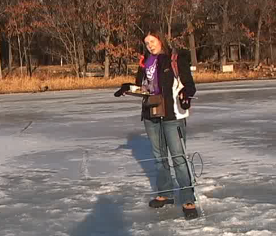On many winter days, a group of people walk across frozen Lake Judy in Shoreview, Minn., with a contraption that looks like it’s straight out of a sci-fi movie.
The group calls themselves “Team Turtle” and is comprised of biology researchers at St. Thomas who are studying these reptiles and their activity during the winter.
“Turtles don’t hibernate,” senior student researcher Anna Stanislav said. “They brumate, which means their metabolic processes slow way down in cold weather. They survive underwater through gas exchange with their cloaca (anus).”
This means that turtles are still moving under the ice during the winter. The group of researchers, which includes St. Thomas biology department chair Tim Lewis, are wondering how they survive and what they do during the winter periods, especially since they can’t get energy from their environment.
“There’s very little research that has been done with the overwintering of turtles,” Stanislav said. “This is sort of a primary step to answering that question and sort of figuring out what those turtles are doing during the winter. [We want to know] how they act, and how they can survive as well as they do in this climate.”
The research is being conducted on the Mississippi River, some inland lakes in the metro area, including Lake Judy, and a river in Michigan and Ohio. On Lake Judy, the team is tracking 10 turtles this winter.
The researchers work all year on the project. During the summer, they catch, tag and release the turtles back into their habitat. In the winter, they follow the turtles under the ice using radio waves transmitted from the turtle’s tag.
The turtle’s tag is a “radio transmitter that is a little 10-gram item about the size of a salted peanut” that is glued on their top shell. Team Turtle follows the radio signal around to see where the turtles are going, when they’re moving and why they’re moving.
The questions of why and how turtles move during the winter remain unanswered.
Lewis’ team also takes blood samples from the turtles and studies the effects of endocrine disruptors, which are chemicals found in the water that act like a common hormone in turtles.
The specific chemical the team is looking at, bisphenol A (BPA), acts like estrogen. Last year, Team Turtle took blood samples from 150 turtles from 40 lakes across Minnesota.
“As a female, you get a little extra estrogen… that’s not really good for you,” Lewis said. “As a male, I get a little extra estrogen; it’s horrible for me. In humans, it affects reproduction, it affects sperm production, it affects prostrate cancer and testicular cancer. It causes all those to increase.”
Besides the benefits of the research itself, students like Stanislav, who have been on this project for two and a half years, are gaining valuable experience in the field.
“Some of my students are presenting papers at professional conferences and publishing in professional journals. So, [this research provides] incredible educational opportunities for the students.”
Olivia Detweiler can be reached at detw5520@stthomas.edu.



